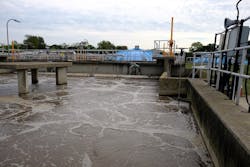What is Waste Activated Sludge (WAS)?
About the author:
Brian Campbell is the founder of WaterFilterGuru.com, where he blogs about all things water quality. His passion for helping people get access to clean, safe water flows through the expert industry coverage he provides. Follow him on twitter @WF_Guru or contact him by email [email protected]
One of the most commonly used sewage treatment processes is the activated sludge process, known as ASP. This article will look at the ASP in more detail, including how the process works, the benefits of this process, and activated sludge modifications.
What Is the Waste Activated Sludge Process?
The waste activated sludge process is a kind of sewage treatment that blows oxygen (or air) into unsettled, raw sewage, which digests pollutants and organic content to keep the biological system in balance. This process is called aeration and takes place in an aeration tank.
There are two types of aeration: pure oxygen aeration and surface aeration.
Pure Oxygen Aeration
Pure oxygen aeration uses sealed-tank reactors containing aerator impellers. This type of aeration is used in wastewater plants that do not have much space. Most sewage plants will avoid this treatment because it incurs higher energy costs.
Surface Aeration
Surface aeration uses vertically mounted tubes that extend around 10 meters high from a concrete tank, which sits below the sewage liquor's surface. The tubes have vanes that connect to the inner surface, and these vanes spin when the tubes are rotated. This sends sewage liquor up from the tubes, and new sewage rises from the bottom of the tank.
Following aeration, the mixed sewage liquor makes its way into a settling tank, which is known as the 'final clarifier'. This allows the sludge blanket, or the biological flocs, to settle and separate from the clean water, which is usually discharged into a soakaway or a watercourse.
The live bacteria makes its way back into the digestive chamber, where it will re-seed the next lot of raw sewage that enters the tank. Any dead bacteria is removed regularly by the service engineer.
What is Waste Activated Sludge Used For?
Sewage and industrial wastewater treatment plants use the activated sludge process for several purposes: to oxidize nitrogenous materials, to oxidize carbonaceous materials, or to remove nutrients like phosphorus.
The Microbes in Activated Sludge
Activated sludge is termed 'activated' because many of its particles are active bacteria and protozoa. These microorganisms are needed in sewage treatment because they can digest sewage bacteria.
There are a variety of microbes that can be found in this sludge. These microbes coexist by serving their own purposes: the big microbes eat the smaller microbes, and the smaller microbes eat the dissolved food.
There are two types of bacteria in the smaller microbes: carbonaceous and nitrogenous bacteria. Carbonaceous bacteria eat particles containing carbon, while nitrogenous bacteria eat nitrogen that contains chemicals.
There are numerous types of big microbes, including flagellates, various kinds of ciliates, amoebae, nematodes, and suctoria.
How Microbes Eat
Microbes do not have mouths, and they do not eat like humans do. Instead, food sticks to the outside of the microbes' bodies, which contain a layer of fat storage. This fat layer also allows microbes to stick together, forming a floc.
What are the Benefits of Waste Activated Sludge?
Activated sludge sewage treatment plants have a number of benefits compared to other types of sewage treatment, namely it is:
- Reliable process
- Not as much 'bad' sludge to get rid of
- Simple, affordable method
- Self-serving - bacteria does not need to be topped up
- No moving parts
- Odorless process
- Allows emptying intervals to be longer
What Are the Issues with Waste Activated Sludge?
Like all forms of sewage treatment, activated sludge has its setbacks. Three common ones are:
- The process requires electricity to transfer the sludge back to the aeration tank and power the aerators. Other kinds of sewage treatment do not need electricity and can simply use gravity to operate.
- In some cases, sludge bulking can prevent activated sludge from properly settling, which affects the quality of the final effluent. Additional steps may need to be taken to prevent sludge bulking, requiring more skilled personnel.
- Parts and materials required for the process may not be available locally.
Modifications of Activated Sludge
There is not one specific activated sludge process that is used across all sewage plants. Instead, different processes are used to address different problems or conditions. These processes have their own characteristics, including their aeration flow patterns and mixing, and how the microorganisms mix with sewage water.
Regardless of the type of modification, all activated sludge processes send the return sludge into the aeration tank first. This return sludge contains microbes that characterize the activated sludge process, and are needed to eat the particles in the settled sewage.
The settled sewage can be added to the aeration tank in several different ways. Aside from conventional activated sludge, the most common modifications include:
- Step aeration;
- Complete mix;
- Extended aeration;
- Contact stabilization;
- Tapered aeration; and
- Pure oxygen.
The Bottom Line
The waste activated sludge process is one of the most effective sewage treatment options. Despite its drawbacks, this process is one of the most efficient and cost-effective processes that is relied upon by many municipalities.
About the Author
Brian Campbell
Brian Campbell is the founder of WaterFilterGuru.com, where he blogs about all things water quality. His passion for helping people get access to clean, safe water flows through the expert industry coverage he provides. Follow him on twitter @WF_Guru or contact him by email [email protected].
